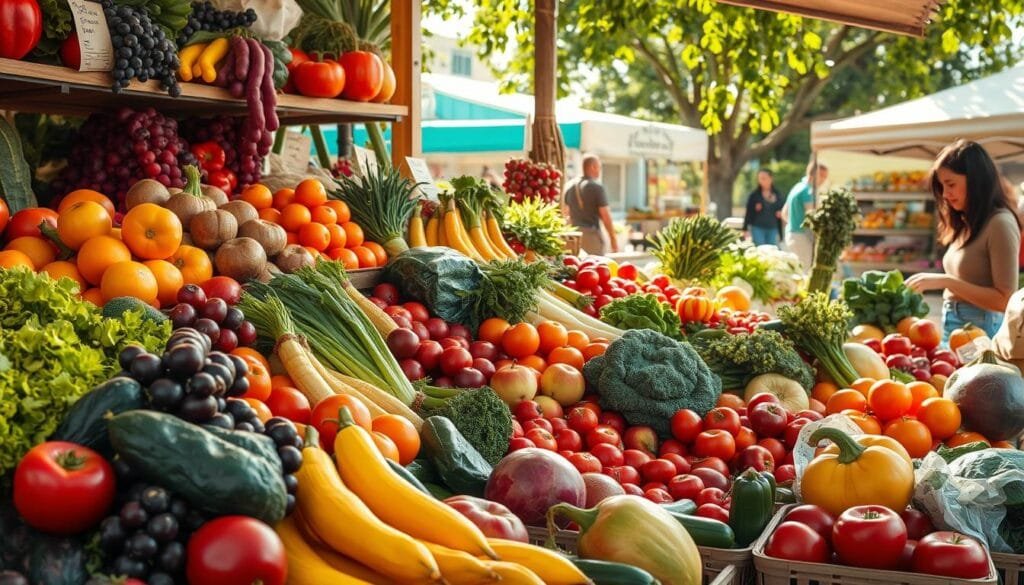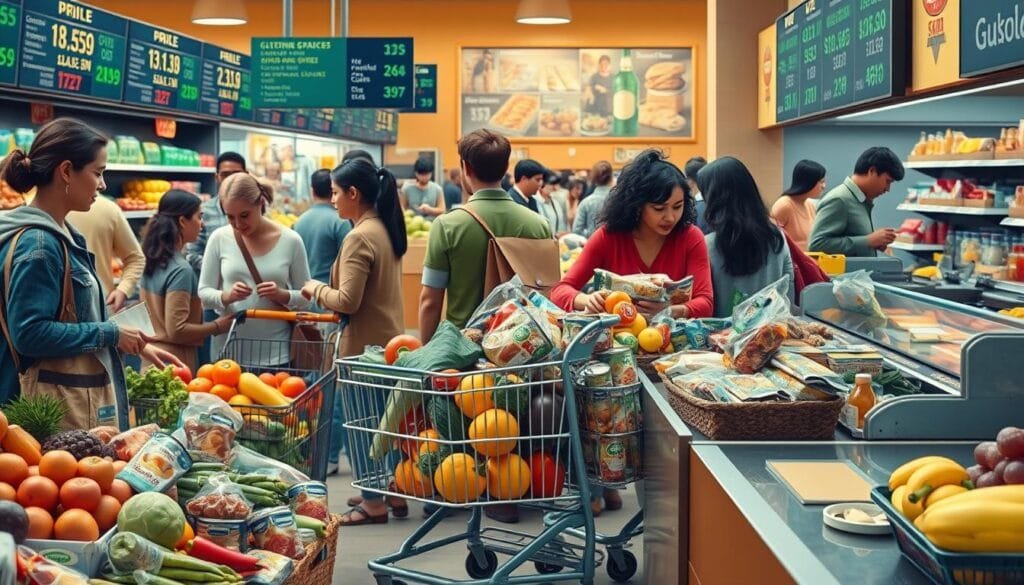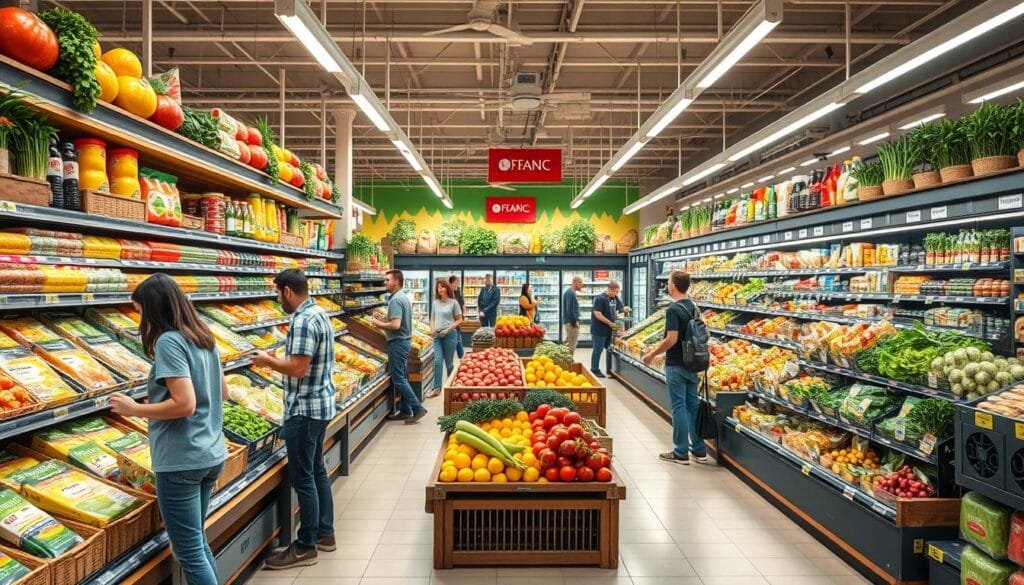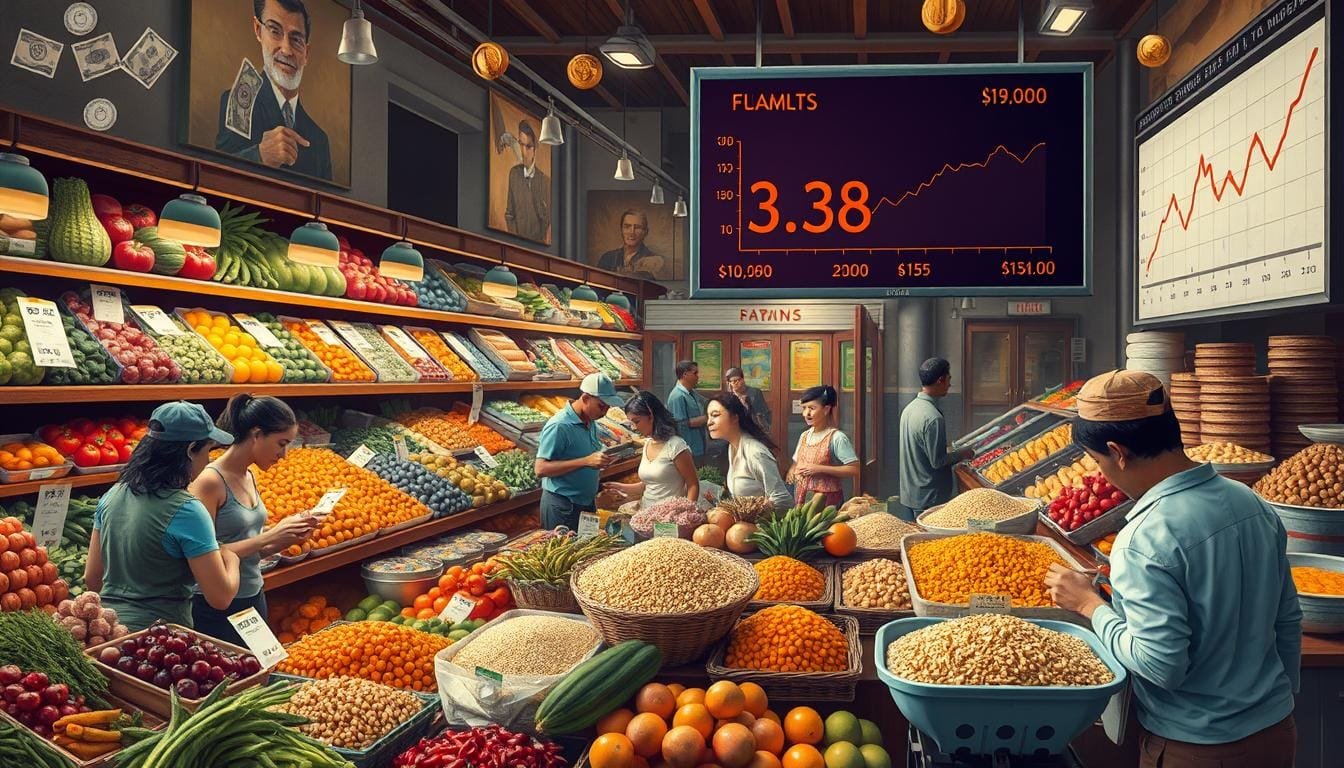Ever wonder how money affects what you eat? This guide helps uncover the link between your wallet and your meals. It shows how our financial status plays a big role in our food choices. It looks at economic influences on diet and the whole idea of food choice economics. This relationship is complex but important to understand.
Lower-income folks often pick foods that are less healthy but fill you up more. We also see how having more money means access to more nutritious foods. Knowing this can help us make better choices that fit our budgets and health needs.
Key Takeaways
- Economic status significantly influences dietary choices.
- Lower-income groups often opt for energy-dense, less-nutritious foods.
- Higher-income families have better access to a variety of healthy foods.
- Socioeconomic differences in food expenditure impact the purchase of fruits and vegetables.
- Supermarket choice plays a role in dietary quality and accessibility.
- Poor diet quality due to economic constraints leads to higher healthcare costs.
Understanding the Basics of Food Economics
Food economics looks into how money factors like supply and demand affect what we eat. It shows why understanding these money factors matters. They determine the cost of healthy eating and how they affect our food choices.
Food pricing plays a key role here. Studies show that people with less money often eat unhealthy diets. This is because junk food is cheaper than healthy options. Eating too much processed food can lead to consuming too many calories without realizing it.
The cost of healthy food often pushes people towards cheaper, less nutritious options. Fresh veggies and lean meats are good for us but can be pricey. This makes them hard to buy for families with less money. Research shows that richer families eat a wider variety of healthy foods. They eat more things like skim milk, yogurt, and lean meats as their income goes up.
Looking at the economic factors of diet means looking at food costs from production to sale. Prices can be higher in city markets than those outside the city. This affects where people shop and what they can afford. More food choices can lead to eating more and gaining weight, affecting health.
Family habits and support from others also shape what we eat. What we learn about food at home influences our eating habits. With more people eating out, it’s important to have healthy options in places like schools and workplaces.
These economic factors highlight why we need policies to make food more affordable and accessible. By understanding these issues, we can help everyone make healthier food choices. This can improve public health overall.
Socioeconomic Factors Influencing Dietary Choices
It’s important to know why people choose certain foods. Income, education, and the cost of good food affect our choices.
Income and Food Budget
How much money you make affects what you eat. For example, families with less money often eat fewer fruits, veggies, whole grains, and low-fat dairy. In June 2008, the USDA said a family of four might spend between $588.30 to $1,151.40 a month on food. This shows how money can shape our diet.
Also, many families getting SNAP benefits only get enough for the cheapest food plans. This highlights how crucial income is in deciding what to eat.
Education and Nutritional Knowledge
Education plays a big role in our diet too. People who know more about nutrition tend to eat healthier. A study shows that more education means better food choices.
Knowing how to cook is also key. It helps people eat less processed and fast food.
Cost of Nutritious Foods
Healthy food being expensive is a big problem for many. A table below shows how food prices differ in various cities. This shows the challenge in accessing affordable, nutritious food.
| City | Whole Milk ($) | Lettuce ($) | Canned Peaches ($) |
|---|---|---|---|
| New York (Manhattan), NY | 2.12 | 1.83 | 2.17 |
| Chicago, IL | 2.49 | 1.20 | 2.02 |
| South Bend, IN | 1.64 | 1.01 | 1.41 |
Considering these obstacles, it’s clear that making healthy food affordable is complex. It involves looking at income, education, and food prices.
Health Implications of Economic Constraints on Food Choices
Economic challenges can harm diet quality, leading to health risks. Many people, especially in poorer areas, suffer from bad eating habits due to financial limits. This often means they can’t get enough nutritious food, worsening health issues like obesity, diabetes, and heart diseases.
Nutrient Density and Diet Quality
The affordability of nutrient-rich food affects diet quality. Families with lower incomes usually eat more calories but fewer essential nutrients. This is because cheaper foods are often processed and lack important vitamins and minerals. Places with little access to fresh produce see more obesity and diabetes. Yet, areas with good access to healthy food have fewer of these problems.

A 2015 study found the closest supermarket is about 2.19 miles from U.S. homes. Roughly 23.5 million people in the U.S., especially in poor areas, live over a mile from a large grocery store. This makes it hard for them to buy fresh, healthy food, affecting their diet quality.
Health Risks and Low-Cost Diets
Poor diets can lead to many health problems. Economically struggling groups are more likely to get diseases linked to diet. This includes diabetes, heart disease, and some cancers. They often eat foods high in energy but low in nutrients because those foods are cheaper. This results in both insufficient and excessive nutrition.
Making healthier foods cheaper and offering financial rewards can help. Programs like the Gus Schumacher Nutrition Incentive Program improve access to fruits and vegetables for low-income families. Local projects are also vital for making healthy food more available in needy areas. For example, the REACH program works to better food security and diet quality community-wide.
Still, many poor people have trouble eating healthily due to money, education, and lack of cooking facilities. Solutions need to focus on education, financial aid, and easier access to good food. This can help reduce the bad health effects of economic challenges on food choices.
How does economics affect someone’s food choices simple
Understanding how money impacts what we eat is crucial. Your wallet size can greatly influence your food choices. Often, when money is tight, people go for cheaper, less nutritious foods.

Hard times push families towards more affordable meals. For instance, regular beef costs 43 percent less than alternatives like plant-based options. This makes it a go-to despite not being the healthiest choice. Also, in food deserts across the U.S., healthy options are scarce. People there might eat foods high in calories but low in nutrients because that’s all they can find.
The spike in veganism shows how money shapes diets too. Between 2014 and 2017, the number of vegans went up by 600 percent. Vegans often pay 65 percent more for their meals than those who eat everything. This points out that your income can limit or expand your food choices.
Persistent household food insecurity is linked with a 22 percent increase in childhood obesity compared to food-secure homes, illustrating further the health vulnerabilities connected to economic hardship.
The stores where people shop also say a lot about income and food choices. On average, Whole Foods shoppers make about $80,000 a year. This is way more than the U.S. median of $30,000. So, higher-income families can afford better, organic foods, while others might have to settle for cheaper, less healthy options.
| Economic Factors | Impact on Food Choices |
|---|---|
| Median Income | Choice of budget supermarkets over organic stores |
| Food Deserts | Increased reliance on low-nutrient, high-calorie foods |
| Vegan Diet | 65% higher meal cost compared to non-restricted diets |
| Economic Downturns | Increased selection of cheaper, calorie-dense foods |
In short, looking into how economics affects food choices reveals a big truth. Money—or the lack of it—drives what we eat. We must understand this to make better choices and improve everyone’s health.
The Role of Supermarket Choice in Dietary Quality
Supermarket choice matters a lot when it comes to what we eat. This becomes clear when we look at expensive versus cheaper supermarkets. It also matters where these stores are located. Efforts to make better food more available have changed how people shop and eat.
High-Cost vs. Low-Cost Supermarkets
Stores that charge more usually have more fresh and healthy foods. This can lead to a better diet. On the other hand, cheaper stores might not have as much good produce or healthy items. For example, lower-income places see less fruit and veggie purchases.
People who get help from programs like SNAP or WIC often go to bigger stores. This is true even when money is tight.

Studies show that richer families tend to eat better, like more veggies and dairy. The choice of store and how things are priced affects this. You can learn more about these findings here.
Impact of Accessibility and Geography
Where you live and how easy it is to get to a good store matters a lot for eating well. The USDA has put in almost $500 million since 2011 to help with this. An example is the Pennsylvania Fresh Food Initiative which combined public and private money for better access.
Food deserts are places where it’s hard to buy affordable, good food. People in these areas buy less healthy stuff like low-fat milk and more red meat. Most families, said a 2012-13 survey, shop mainly at big supermarkets or supercenters. This shows how important grocery stores are. People in hard-to-reach places even bought more fruits and veggies if they traveled further to shop.
Below is a comparative analysis of purchasing behaviors in different accessibility contexts:
| Category | Low-Access Areas | High-Access Areas |
|---|---|---|
| Fruit Purchases | 4.3% less | 4.3% more |
| Vegetable Purchases | 2.4% less | 2.4% more |
| Low-fat Milk Products | 10.4% less | 10.4% more |
| Red Meat | 8.6% more | 8.6% less |
This data shows big differences in what people eat based on where they live and their budgets. Improving access to good grocery stores and helping low-income areas can make a big difference in eating well.
Conclusion
As we wrap up our look at food economics, it’s clear money plays a big role in our food choices. We’ve learned that affordability, access, and knowing what’s good for us impact what we end up eating.
From 1978 to 2007, the cost of healthy foods like fruits and veggies went up around 18%. At the same time, not-so-healthy options like soda got 38% cheaper. This shows the challenges families face in trying to eat well on a budget.
Also, for families using SNAP benefits, making healthy meals takes both money and time. For example, following the Thrifty Food Plan guidelines means spending up to 72 minutes a day cooking. That’s almost double the time compared to not following it, and it costs more too.
We’ve highlighted the importance of policy changes to make healthy eating easier for everyone. If food that’s good for us is easier to get and not so expensive, healthier diets can be a reality for all. This journey into the economics of eating shows it’s a big issue that needs teamwork from experts in many fields. Together, they can make a difference in making nutritious food a choice that’s easy for everyone to make.
FAQ
How do economic conditions shape dietary habits?
Economic conditions dictate what foods people can buy. Those with less money often buy cheaper, less nutritious foods. This leads to different diets among various income groups.
Why do lower-income groups often choose less nutritious, energy-dense food options?
Cost constraints make lower-income groups choose less nutritious foods. These foods offer more calories for less money. They are a practical option for those with tight budgets.
How does one’s income level influence food purchasing decisions?
Your income level affects what food you can buy. People with more money can choose healthier options. Those with less need to pick cheaper, less nutritious foods.
What role does education play in food choices and nutrition?
Education impacts food choices and nutritional awareness. People with more education tend to eat healthier. They know the benefits of a balanced diet and choose nutritious foods more often.
Why are nutritious foods often more expensive?
Nutritious foods cost more due to higher production and transport costs. Fresh fruits, vegetables, and lean meats need more resources, making them pricier than processed foods.
What health risks are associated with diets low in nutrient density?
Diets low in nutrients but high in calories pose health risks. They can lead to obesity, diabetes, and heart disease. Eating too many cheap, processed foods harms your health.
How do economic downturns affect dietary choices?
Economic downturns push people to focus on cheap food over nutrition. This means more consumption of less nutritious foods. Such choices can harm health over time.
What is the significance of supermarket choice in dietary quality?
The supermarket you choose influences your diet quality. Stores with higher prices often offer more healthy choices. But, low-cost stores might limit access to nutritious foods, affecting diets.
How do food deserts impact low-income neighborhoods?
Food deserts harm low-income areas the most. They lack affordable, nutritious foods. This shortage means people in these areas struggle to eat healthily, worsening dietary and health gaps.
